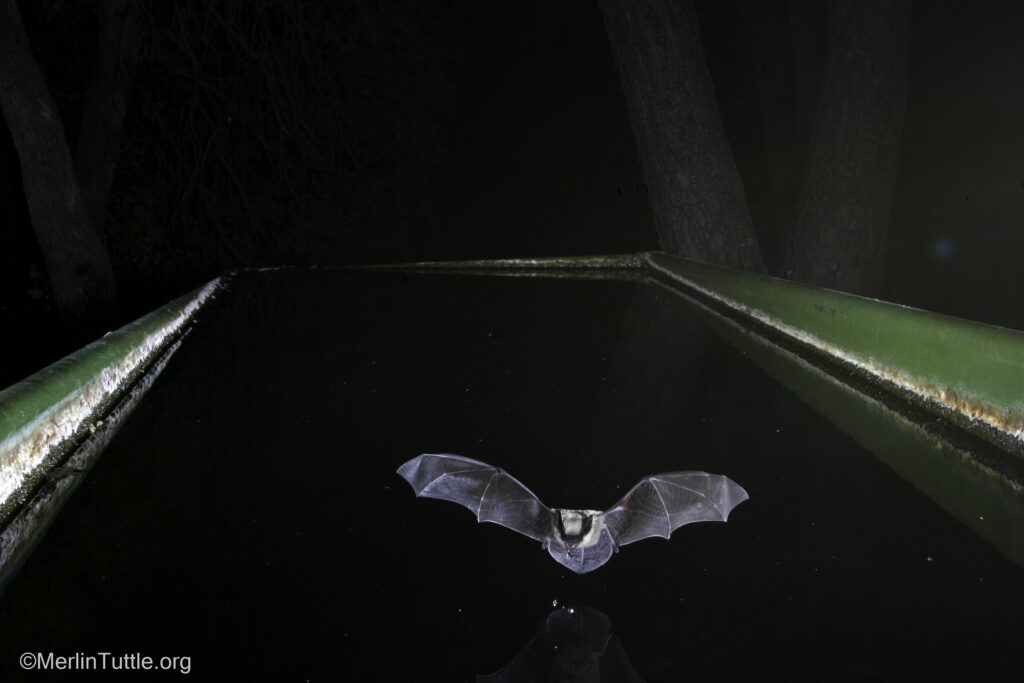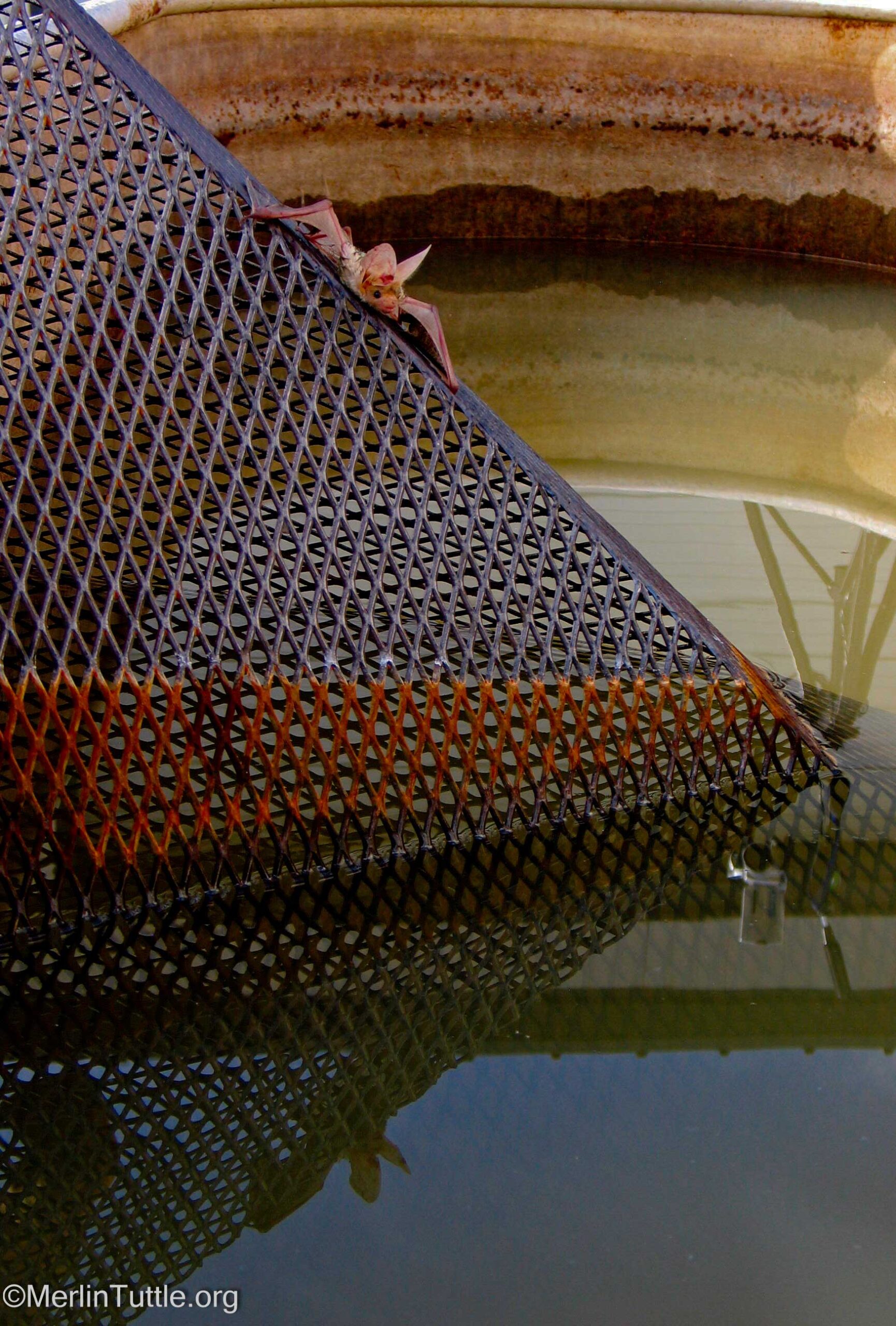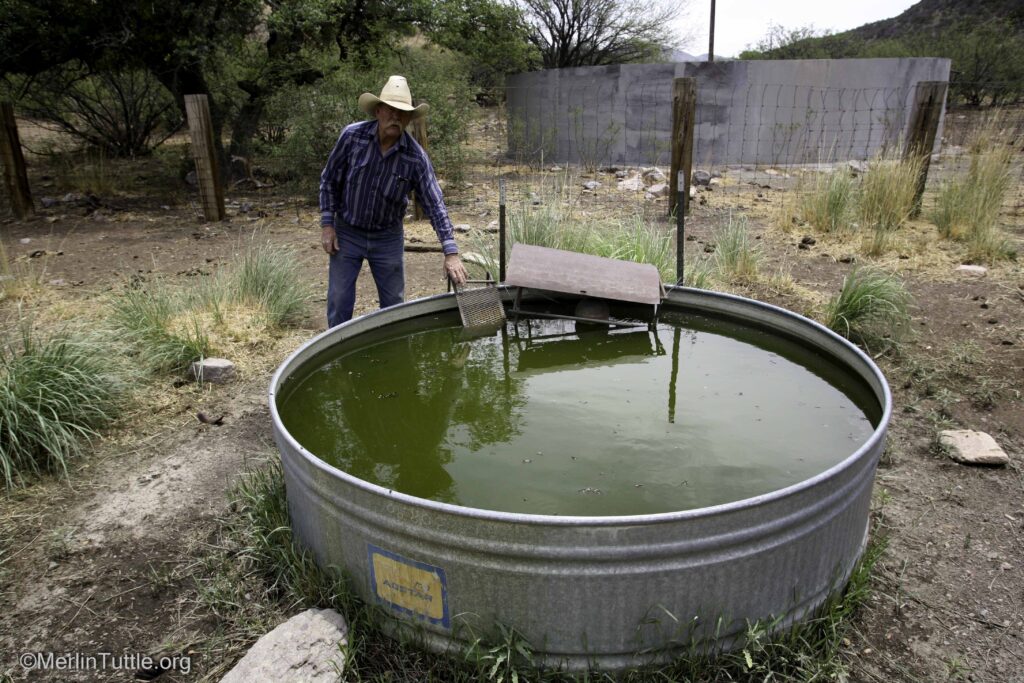Batty Gifts for Bat Fans
Are you looking for gifts that delight bat lovers while supporting conservation and education? From beautifully illustrated picture books for young readers to behind-the-scenes storytelling,
Mirror Mirror on the Wall, who’s the Thirstiest of Them All?
Water is nature’s mirror. However, rather than reflecting back, when horizontal sound hits the smooth surface of a pool, it bounces away. By this reasoning bats intuitively locate potential drinking opportunities when their downward echolocation calls do not return. Instead, there is only silence, revealing a water source. Bats drink on the wing, skimming the surface of still pools, with mouth agape and sometimes with tongue extruded (while some use more creative techniques like wetting their bellies as they fly over and licking the moisture they collect on their bodies).
Water is important for all life, but for bats getting a drink, it can be critical to survival. Because many bats have small bodies, most weighing less than 20 grams, and exposed wing surfaces, they tend to lose water through evaporation quite readily and this is especially true in low-humidity environments. For females during the breeding season, body water loss is magnified by the production of milk (composed of 75% water) that is needed to feed young that grow to adult size in just a few weeks. This enormous production of lactate requires females to consume large amounts of water during the hot summer months. (Yes, juveniles can and do drive their mothers to drink!)
In the dry ponderosa pine woodlands of the eastern Colorado foothills, we used passive integrated transponders (PIT-tags) placed under the skin of lactating and nonreproductive female fringed myotis (Myotis thysanodes) to track their drinking habits. Our submersible PIT-tag reader showed that lactating females visited to drink between six and 10 times more per night than nonreproductive females. We also showed that reproductive females form maternity colonies in rock crevices near small, but persistent, water sources that they can access immediately after leaving their hot day roosts at dusk.
With climate warming in Colorado, we have documented increasing temperatures and drought over the last two decades. In drought years, our capture data showed significant reductions in reproductive output of most bat species and these declines were clearly correlated with drought-based reductions in stream flow as directly related to lactation ability. Our data have also shown that females who successfully rear young during droughts tend to give birth to males, skewing the sex ratio from 50:50 females/males to 80% males in some years. These factors do not bode well for bats. As water availability diminishes, more species will begin to fall into the abyss of extinction.
Another aspect of water availability, or lack thereof, concerns the population ecology and coexistence of bat species. We have shown that those species sharing the same water sources near maternity roosts are competing for limited drinking space. To avoid this, different species stagger their drinking times. Even though there is overlap in activity among species, peak activity times for each species were significantly different. As water availability in the region diminishes over time, this likely will lead to greater competition among species vying for a place at the water fountain, possibly leading to the extirpation of some.
Because bats drink on the wing, safely approaching small pools to skim the surface can be quite challenging, especially with other bats also trying to get a drink. Using a thermal imaging camera, we have shown that bats align in a specific drinking pathway relative to the water’s surface – the orientation of which differs among drinking pools. Bats coming in to skim enter a specific and precise flight lane, not unlike a landing strip at an airport, to avoid collisions with other bats trying to drink. Our video shows dozens of bats flying in chaotic patterns a few meters above the pool, but once individuals decide to skim for a drink, they circle the outside perimeter and drop down, entering into the precise approach path.
Thermal imaging camera footage of bats following drinking pathways to avoid collisions with other bats trying to drink. (Source: Adams RA, Simmons JA. 2002. Directionality of drinking passes by bats at water holes: is there cooperation? Acta Chiropterologica 4:195-199.)
Astonishingly, this “agreement” on a precise skimming route is struck among nine species, all using the same drinking pool and rarely is any alternate approach path attempted. This clearly shows that cross-species communication occurs in bats one way or another and when bats go to different drinking pools, they know what the agreed upon approach angle is for that spot. The socioemotional lives of bats is poorly known, but appears to be highly interactive and complex.
Many water sources are not accessible to bats due to their diameter and/or obstacles that can dissuade them from attempting to drink. The body size and dimensions of bats wings determine their flight agility. Typically, smaller bats with shorter, broader wings fly slower and are more maneuverable — thus having access to the smaller and more cluttered sites. In 2013, a 1,000-year flood cleared out all vegetation along two of our research canyon streams, opening up many more drinking pools for bats. The bat activity in these canyons increased exponentially after that event.
Many bats also use human-built water catchments such as cattle troughs. It has been shown that more bats will use these troughs if they are long and narrow rather than circular. Unfortunately, using these artificial catchments can be life-threatening. When trough water levels become low, bats can fall in and be unable to escape slick metal sides. Bat biologists have developed small ladders that can be placed inside cattle troughs, allowing bats and any other wildlife to climb out. In some areas, ranchers place water troughs beneath obstacles such as barbed wire fences. While this allows cattle from different pastures to share water, such convenience can become deadly for bats.
Simply understanding bat needs can be of huge importance to their survival. Avoiding obstacles (including plant overgrowth that prevents in-flight drinking), providing escape ladders in water troughs, or lengthening a pond for faster flying species, can save many lives.
While this blog focuses solely on drinking, water in streams and rivers also provides an ideal food source. Emergent aquatic insects sometimes hatch in dense swarms that are easy food for many animals, including bats. Thus, loss of water is a double-whammy for insectivorous bats, birds, and other wildlife. As climate warming and drought tighten their grip, our data and experiments from our field sites in Colorado provide a model of anticipated effects that will likely cascade through many ecosystems around the globe – significantly affecting myriad habitats and wildlife species. The wisdom of bats gathered over the last 55 million years is telling us to change our ways to avoid climate catastrophe. Will we?



Dr. Rick Adams is a welcome new addition to the Board of Directors for MTBC. He is Professor Emeritus at the University of Northern Colorado in Greeley, Colorado. Rick has studied bats since 1984 in Colorado, Wyoming, Caribbean Islands, South Africa, Botswana, and Namibia as well as in Giant Panda habitat of Sichuan Province, China. His research encompasses Ecology, Evolution, and Conservation. He is also President and Founder of the Colorado Bat Society that works to conserve bats and their habitats in Colorado.
Love our content? Support us by sharing it!
Are you looking for gifts that delight bat lovers while supporting conservation and education? From beautifully illustrated picture books for young readers to behind-the-scenes storytelling,
Bats are often misunderstood, but a new book is helping change that. In The Genius Bat: The Secret Life of the Only Flying Mammal, neuroscientist
Our fourth annual Join the Nightlife workshop, held in Central Texas, brought together conservationists, researchers, and farmers from around the U.S. to explore the many
Bats are the longest-lived mammals for their size, with species like the little brown bat (Myotis lucifugus) surviving over 30 years in the wild. Even
2024 © Merlin Tuttle’s Bat Conservation. All rights reserved.
Daniel Hargreaves is a lifelong bat conservationist who has worked globally to facilitate progress, including co-founding Trinibats, a non-profit bat conservation organization in Trinidad. He has organized and led field workshops worldwide, including five for MTBC. Following a long and successful career in business, he now manages a network of bat reserves for the Vincent Wildlife Trust in the UK, supervising research and development of new and innovative conservation techniques. Daniel also is one of the world’s premier bat photographers.
Madelline Mathis has a degree in environmental studies from Rollins College and a passion for wildlife conservation. She is an outstanding nature photographer who has worked extensively with Merlin and other MTBC staff studying and photographing bats in Mozambique, Cuba, Costa Rica, and Texas. Following college graduation, she was employed as an environmental specialist for the Florida Department of Environmental Protection. She subsequently founded the Florida chapter of the International DarkSky Association and currently serves on the board of DarkSky Texas. She also serves on the board of Houston Wilderness and was appointed to the Austin Water Resource Community Planning Task Force.
Michael Lazari Karapetian has over twenty years of investment management experience. He has a degree in business management, is a certified NBA agent, and gained early experience as a money manager for the Bank of America where he established model portfolios for high-net-worth clients. In 2003 he founded Lazari Capital Management, Inc. and Lazari Asset Management, Inc. He is President and CIO of both and manages over a half a billion in assets. In his personal time he champions philanthropic causes. He serves on the board of Moravian College and has a strong affinity for wildlife, both funding and volunteering on behalf of endangered species.